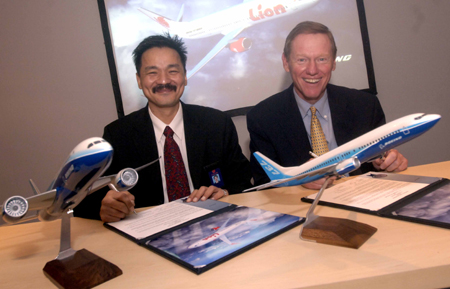By Mark Pilling at Farnborough
Six years ago Rusdi Kirana was eating a burger with his wife sitting on the grass overlooking the Farnborough runway. He was at the biannual airshow looking to acquire his first aircraft for Indonesian start-up carrier Lion Air. But he confesses that back then he didn’t know where to go or who to approach.
The contrast with this year could not be starker: at mid-July’s show Kirana was having lunch with Alan Mulally in the more impressive surroundings of the manufacturer’s chalet (see picture below). The Boeing chief was beaming as Kirana had just exercised options to buy another 30 737-900ERs. Valued at over $2.2 billion at list prices, the 30 737s doubles the number Lion Air will acquire, with first deliveries starting in April 2007.

Lion Air launched the 737-900ER (Extended Range) in July 2005. The carrier needs the extra range offered by this 737 variant because many of its stage lengths are of seven hours in duration across the vast distances of the Indonesian archipelago.
Kirana, who has the title of president director at his carrier, said the initial 30 737s are set to replace its fleet of 35 737 Classics, MD-80s and MD-90s. “The next 30 are for growth,” he said, with more to follow. “Even this order is not enough,” he added.
Lion Air is one of several start-ups in Indonesia in the past few years and one of the fastest growing. It began with a wet-leased 737-200 with flights between Jakarta and Pontianak in June 2000. Kirana is a travel agent who founded the low-cost carrier with his brother with an $850,000 investment.
The new entrant has risen swiftly to capture a 32% share of the domestic market and is achieving load factors of 91%, he said. It is a market that is growing by 25% annually and saw some 35 million air travellers in 2005.
Kirana is riding this wave of success. “When I came here to order Boeing aircraft I said to Alan that you are going to make me a billionaire. I am going to have a big profit with your 737s.” Kirana told Mulally that he intends to use that profit to become a 787 customer. The aim is to take its first 787 – which would have to be leased – by 2010, he said.
Kirana has just finished a round of discussions with European and US banks about raising the finance for its new orders. At present around half its current fleet is owned. With no debt and a profitable operation, although the privately held carrier releases no financial figures, Lion Air is seen as an attractive investment, he said.
The carrier could move for a public listing, but that is not in Kirana’s plan. “We want to have our freedom just to run this company,” he said.
Source: Airline Business
















